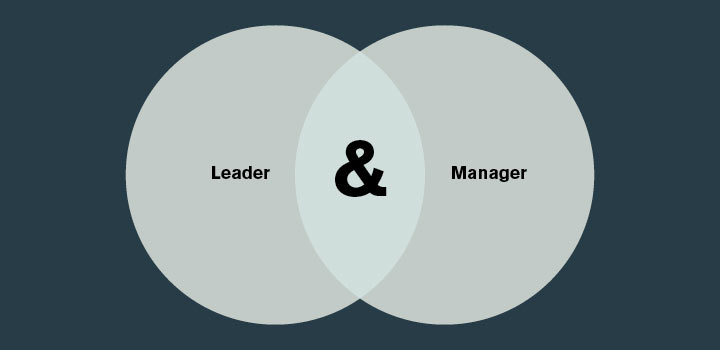5 key points to help you know if you are a manager or a leader?
For many years, we have been taught that management will have to do jobs related to prediction, budgeting, planning and control. Managers are trained to manage, not leaders.
The managers (Manager) have long been trained and supervisors (Supervisor) trained to assign tasks to subordinates, how to evaluate the work of team members, support staff to improve work performance, while firing and recruiting new employees.
We have (and are) using the principle of "sticks and carrots" to ask employees to work but in the end, if they don't have the spirit, the motivation to work, don't care about the mission, the leader religion and / or something else related to the organization will eventually be broken.
This is when we need to think about leadership (Leadership) and the leader (Leader).

Today, human leadership based on trust and empathy is not only an effective way to manage a team but also the most profitable, long-term way for businesses.
The question is: How do you know if a person is a manager or a leader or more correctly, what are the key differences between management and leadership?
Before going on to clarify the signs to recognize, it is necessary to affirm two things: leadership and management are two completely different categories, at the same time, a person who is a manager is not likely to be able to receive director!
There is an interesting example that the manager will say "Go!", The manager will say "Let's go!". One side is an order (management) and one party is also an order, but it contains that everyone moves forward, including both employees and leaders (Let's go = Let us go).
1. Management is reactive (Reactive), leadership is super active (Proactive)
As a manager, you are responsible for giving instructions. When something does not happen according to the plan, naturally, you will have to react to those bad (or good) situations, such as asking employees to find out the cause, who is responsible. , calculate risks, losses and offer solutions to overcome.
A leader is not merely doing such things. If you are a good leader, you will have to anticipate changes, prepare everything in advance (including market analysis, forecasting, risk measurement, contingency .), ensuring safety. For all members and maintain increased profits even in bad situations.

The typical "super active" Leader always keeps a calm, eloquent attitude, has the belief that the team can overcome all the challenges that are coming, and always have a plan for actions and events. Surprise may occur. As a result, the working environment rarely falls into extreme stress.
With all these factors, a good Leader needs to excel both in management and leadership.
2. Managers with employees, leaders with "followers" (Follower)
You are a good manager, managing 5 to 10 employees in a small company. This is a fixed number. You are responsible for the situations that occur and the role-playing staff will report to you the progress of the work as well as the results. You are the commander, the employee is the one who obeys the order.
As a leader, you will train, train and help your employees to become leaders using KPI (Key Performance Indicator) performance indicators instead of tell staff what they have to do. The more you become an exemplary leader, the more people you follow, learn from the experience and become a role model for all levels of effort to become.
You will be managed when assigned to hold that task, but to become a true leader - that is, a "follower" takes time and a person who wishes to become a Leader needs to understand that.
3. Manage creating Groups, leaders create Teams
This is the inevitable result of the above mentioned problem - in the Manager role, you manage the subordinates, assigning tasks to each person and each person will be responsible for completing the received part. It seems that the connection between the Group members is faint, you can only control them but cannot create energy to unify them. On the other hand, being a Leader, you are like a director of a play and for the play to be successful it needs the participation of all the actors in the show.
As a Leader of a Team, you can unleash the power of each member of the team and all will work together to create results. Each person is an independent person but once linked together, your Team will become more united and stronger than ever.
4. Manager transfers responsibility, Leader accepts responsibility

Manage work allocation and when incidents occur, at which stage the staff / department responsible for that part will be responsible. Rather, manage authorization both for work and for errors (if any).
Once you are ready to take responsibility, take responsibility and do not attempt to push the mistake to your subordinates, you are a leader.
5. Leader is ready to assist when staff needs, Manager does not
A manager just finished their task at the office and then went home when finished.
The leader is willing to work overtime, ready to assist when employees need to be in trouble and it seems that all hierarchical differences are removed when all team members work hard to accomplish the task. service.
These are the main differences between a leader and a manager. If you want to become a Leader, now manage in the style of a leader.
You should read it
- 21 mistakes that an excellent manager never really make
- 4 skills to help you become a good leader
- 10 potential challenges that leaders face and solve
- Former General Electric Jack Welch CEO: the quality of leadership is both innate and moderate, through training
- 10 mistakes in management will 'kill' the motivation of the group
- 19 soft skills that those who want to be good leaders must also have
 6 types of bosses make any good employee want to 'run'
6 types of bosses make any good employee want to 'run' Why are smart people usually few?
Why are smart people usually few? 8 thoughts that help smart people turn to victory
8 thoughts that help smart people turn to victory Make sure you can't get rich if you're still conservative with these 15 thoughts
Make sure you can't get rich if you're still conservative with these 15 thoughts 5 absolute sentences must not be said during the job interview
5 absolute sentences must not be said during the job interview War and 10 inspirational stories live
War and 10 inspirational stories live